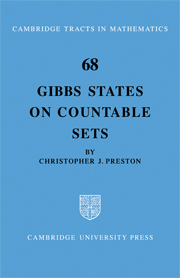Book contents
- Frontmatter
- Contents
- Preface
- 1 Gibbs states and Markov random fields
- 2 Interacting particle systems
- 3 Coupled Markov chains
- 4 Gibbs states and Markov random fields on countable graphs
- 5 Gibbs states on countable sets
- 6 Kirkwood–Salsburg equations
- 7 Involutions of P(S)
- 8 Attractive and supermodular potentials
- 9 Attractive pair potentials
- 10 Examples of phase transition
- 11 11 The extreme points of GV
- Appendix The Lee-Yang circle theorem revisited
- Bibliography
- Index
- Frontmatter
- Contents
- Preface
- 1 Gibbs states and Markov random fields
- 2 Interacting particle systems
- 3 Coupled Markov chains
- 4 Gibbs states and Markov random fields on countable graphs
- 5 Gibbs states on countable sets
- 6 Kirkwood–Salsburg equations
- 7 Involutions of P(S)
- 8 Attractive and supermodular potentials
- 9 Attractive pair potentials
- 10 Examples of phase transition
- 11 11 The extreme points of GV
- Appendix The Lee-Yang circle theorem revisited
- Bibliography
- Index
Summary
In the last few years there has been a great deal of interest in problems arising in classical lattice statistical mechanics. The aim of this book is to provide to mathematicians with no background in physics an introduction to some of the results in this field. As the average mathematician probably has difficulty in understanding the language of mathematical physics, the approach of the book is to consider the subject as a branch of probability theory. It is thus assumed that the reader is acquainted with some of the basic facts of probability theory (e.g. σ-algebras, probability measures, finite state Markov chains), but apart from this the material is self-contained.
The basic objects to be studied will be certain classes of probability measures on P(S)</*i>, where S is a set (finite or countably infinite) and P(S) denotes the set of subsets of S. The points of S can be interpreted as sites, each of which can be either empty or occupied by a particle, and the subset of A ∈ P(S) can be regarded as denoting when there are particles at exactly the points in A. Thus the probability measures on P(S) describe the distribution of configurations of particles; and they will usually represent the equilibrium distribution of some physical model.
- Type
- Chapter
- Information
- Gibbs States on Countable Sets , pp. vii - xPublisher: Cambridge University PressPrint publication year: 1974

